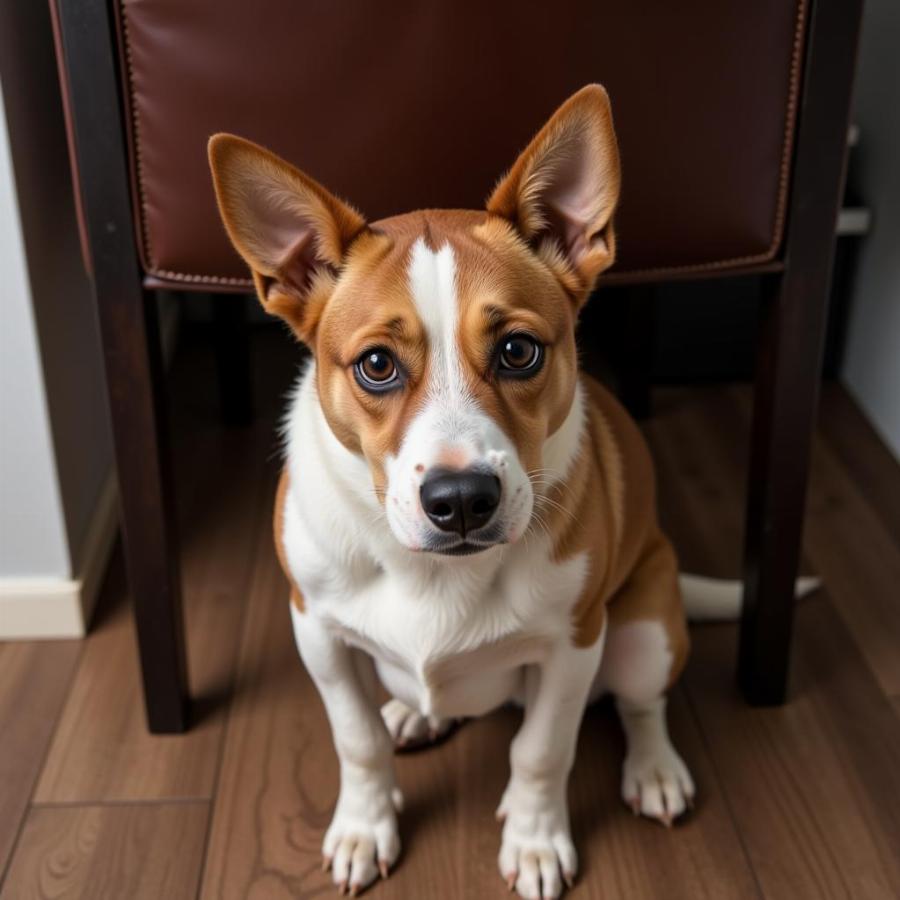Courage the Cowardly Dog, with his iconic screams, has become a symbol of fear and anxiety, albeit in a cartoonish way. While our canine companions might not face the same otherworldly threats as Courage, they experience fear and anxiety in their own lives. Understanding these emotions in our dogs is crucial for responsible pet ownership. This article will explore the various aspects of fear and anxiety in dogs, how to identify the signs, and strategies for managing them. Understanding “courage the cowardly dog screaming” can help us empathize with our furry friends and address their anxieties more effectively.
Recognizing Fear and Anxiety in Dogs
Fear and anxiety manifest differently in dogs. Just like interpreting “courage the cowardly dog screaming,” understanding canine body language is key to recognizing their emotional state. Some common signs include:
- Whining and barking: Excessive vocalization can be a sign of distress.
- Trembling and shaking: These are classic physical manifestations of fear.
- Pacing and restlessness: An inability to settle down can indicate anxiety.
- Destructive behavior: Chewing, digging, and scratching can be outlets for anxiety.
- Excessive panting and drooling: These can be physiological responses to stress.
- Hiding and withdrawal: A dog seeking refuge might be feeling overwhelmed.
- Aggression: In some cases, fear can trigger aggressive behavior.
 Nhận biết nỗi sợ ở chó
Nhận biết nỗi sợ ở chó
Common Triggers of Fear and Anxiety
Understanding what triggers fear and anxiety in dogs is the first step towards helping them cope. These triggers can range from loud noises, like fireworks (think of Courage’s reactions!), to unfamiliar people or situations. Some common triggers include:
- Loud noises: Thunderstorms, fireworks, construction sounds.
- Separation from owners: This is a common cause of anxiety, often manifested as separation anxiety.
- Unfamiliar people or animals: New encounters can be overwhelming for some dogs.
- Changes in routine: Moving to a new home or changes in daily schedules.
- Veterinary visits: The unfamiliar environment and potential for discomfort can be stressful.
Managing Fear and Anxiety: Creating a Safe Space
Providing a safe and secure environment for your dog is crucial, just like Muriel provides for Courage. This could be a quiet room, a crate, or even just a designated corner where they can retreat when feeling anxious. This safe space should be associated with positive experiences, such as treats and toys.
courage the cowardly dog memes
Techniques for Calming an Anxious Dog
There are several techniques you can use to help calm your anxious dog. These include:
- Counter-conditioning and desensitization: Gradually exposing your dog to the feared stimulus in a controlled and positive environment.
- Behavioral modification: Working with a certified dog trainer or behaviorist to address the underlying causes of anxiety.
- Medication: In some cases, medication may be necessary to manage severe anxiety. Always consult with a veterinarian.
When to Seek Professional Help
If your dog’s anxiety is severe or impacting their quality of life, it’s essential to seek professional help. A veterinarian or a certified dog trainer/behaviorist can provide tailored advice and support. Just like Courage often seeks guidance from the computer, sometimes we need to seek expert help for our dogs.
courage the cowardly dog wallpaper
Conclusion
Understanding and addressing fear and anxiety in dogs is a vital part of responsible pet ownership. By recognizing the signs, understanding the triggers, and implementing appropriate management strategies, we can help our canine companions live happier, healthier lives. Just as we appreciate the humor and heart in “courage the cowardly dog screaming,” we can learn to empathize with and address our dogs’ fears with compassion and care. Remember, providing a safe, secure, and loving environment is essential for a well-adjusted dog.
FAQ
-
Q: What are the most common signs of anxiety in dogs?
-
A: Common signs include whining, barking, trembling, pacing, destructive behavior, excessive panting, hiding, and aggression.
-
Q: How can I create a safe space for my anxious dog?
-
A: Designate a quiet area, like a crate or corner, where your dog can retreat. Make it positive with treats and toys.
-
Q: When should I seek professional help for my dog’s anxiety?
-
A: Consult a professional if your dog’s anxiety is severe, persistent, or affecting their quality of life.
courage the cowardly dog scream
Suggested related articles on Beaut Dogs:
Beaut Dogs is your ultimate resource for all things dog-related, offering expert advice, breed information, and care tips. From understanding the nuances of “courage the cowardly dog screaming” to practical guidance on dog ownership, we’re here to help. When you need support, contact us at Email: [email protected] to get detailed and accurate answers from Beaut Dogs. Visit https://beautdogs.com for more information.